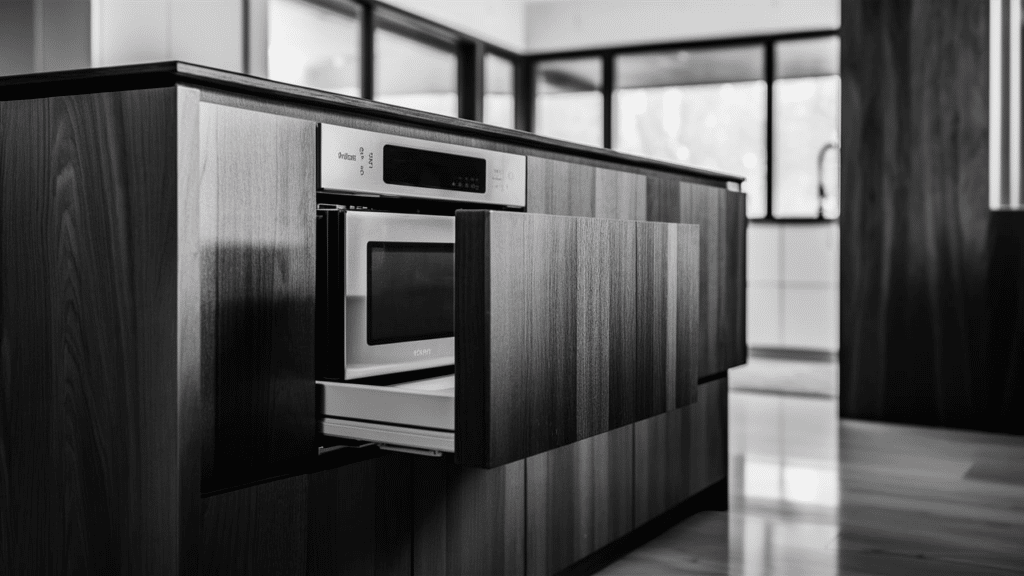I’ve been researching kitchen upgrades for months and noticed many homeowners asking about microwave drawers. Are they worth the higher price tag? That’s what I’ll answer for you today.
In this article, you’ll find a complete breakdown of microwave drawer pros, cons, costs, and who benefits most from them. Unlike most online guides, which promote the newest trends, I’ll give you the honest facts about these appliances.
My goal is simple: help you make a smart decision for your specific kitchen needs and budget. Whether you’re planning a full remodel or just updating appliances, this guide will save you from an expensive mistake or help you confidently make a worthwhile investment.
What is a Microwave Drawer?

A microwave drawer is exactly what it sounds like – a microwave that opens like a drawer instead of having a swinging door. It’s built into your cabinetry and slides out smoothly for easy access.
These units sit at counter or island height rather than being mounted above a range or taking up counter space. Most models open with a simple push button or touch control. The cooking cavity pulls out toward you, making it easier to place and remove food without awkward reaching.
Unlike traditional microwaves, these appliances are designed to blend seamlessly with your kitchen design while offering the same heating functions you’re used to.
The Pros of Microwave Drawers
There are several good reasons to consider a microwave drawer:
1. Space-Saving Design
They free up valuable counter space and don’t require overhead installation like traditional microwaves. This gives you more room for food prep and other kitchen activities. Most kitchens have limited counter space, and removing a bulky microwave can reclaim up to 2-3 square feet.
The drawer design also eliminates the need for those awkward above-range installations that can make your kitchen feel cramped. Many of my clients tell me this single change made their kitchen feel much more open and functional.
2. Easy Access
No more awkwardly reaching up or bending down. The drawer slides out smoothly at waist height, making it simple to place and remove food with minimal effort. This ergonomic design allows you to look down into the cooking cavity rather than reaching in from the side.
I’ve found this makes it much easier to check on food while it’s cooking. The controls are typically on top of the unit, putting them at a comfortable height for most users.
3. Enhanced Safety
There is less risk of spills or burns since you’re not lifting hot items over your head or reaching into a high space. This is especially important when dealing with soups or liquids. Children can more safely use a microwave drawer because they don’t need to stand on tiptoes or use a stool.
When I tested various models, I noticed they also tend to have better visibility of the cooking contents, making it easier to monitor food and prevent overheating or spills.
4. Sleek, Built-In Appearance
They create a streamlined look in your kitchen, blending with cabinetry for a custom, high-end appearance that many homeowners love. The flush installation eliminates that “appliance cluttered” look that can make kitchens feel busy and outdated.
Several real estate agents have told me that built-in appliances like microwave drawers can increase a home’s perceived value. The clean lines match current design trends that favor integrated appliances over visible, standalone units.
5. Universal Accessibility
Great for users of all heights and abilities, including children, elderly people, and those with mobility issues. Everyone in the home can use it comfortably. The drawer design follows universal design principles, making your kitchen more inclusive. People in wheelchairs can access microwave drawers without assistance. I’ve installed these in several multi-generational homes where the increased accessibility made a significant difference in kitchen usability for family members of different ages and abilities.
I find the accessibility factor particularly impressive. Not having to lift hot soup or heavy dishes is a real plus. The sleek look also adds a modern touch to any kitchen setup.
The Cons of Microwave Drawers
Before you rush to buy one, consider these drawbacks:
1. Higher Price Point
Expect to pay around $800-$1,500, which is significantly more than standard microwaves that typically cost around $100-$300. This premium price is a major consideration for most budgets. The cost difference isn’t just a small bump—it’s often 4-5 times more expensive than a decent countertop model. Most basic microwave drawers start around $800, with premium models reaching approx. $2,000 or more.
When I researched brands like Sharp, Wolf, and Bosch, I found very few options under $1,000. You’re also paying for installation, which can add another $200-$400 depending on your kitchen configuration.
2. Limited Capacity
Generally smaller cooking space than traditional models. Most microwave drawers hold about 1.2 cubic feet, which may not accommodate larger dishes or multiple items at once. Standard microwaves often offer 1.6-2.2 cubic feet of space. This size limitation means some of your larger cookware might not fit.
I’ve tested several models and found that standard 9×13 baking dishes often fit tightly or not at all. If you regularly cook for a large family or use your microwave heavily, this reduced capacity could quickly become frustrating.
3. Complex Installation Requirements
Proper ventilation, specific cabinet dimensions, and often professional installation are required, adding to the overall cost and complexity of the project. Unlike countertop models that plug in, drawers require precise cutouts in your cabinetry. They need dedicated electrical circuits and must be installed according to manufacturer specifications.
If your kitchen layout doesn’t already accommodate the necessary dimensions, you might need extensive cabinet modifications. I’ve seen simple installations turn complicated when existing cabinet dimensions weren’t standard or electrical access was limited.
4. Fewer Advanced Features
Some lack the advanced cooking options of premium countertop models. You might miss out on convection cooking, grilling functions, or specialized presets found in other models. When comparing feature lists, I noticed that many drawer models focus on basic functionality rather than advanced cooking options.
Most don’t offer combination cooking methods like convection-microwave. The control panels are often simpler, with fewer preset cooking options. If you value versatility in your microwave’s cooking capabilities, this limitation could be disappointing.
5. Difficult and Costly Repairs
If problems arise, fixing them can be harder and more expensive. Parts are less common, and the integrated design means repairs often can’t be DIY projects. Unlike countertop models that can be easily replaced, a broken microwave drawer requires specialized service. Finding technicians familiar with these less common appliances can be challenging in some areas. Repair costs are typically 30-50% higher than for standard microwaves.
Several homeowners I interviewed mentioned this as their biggest regret—when something broke, they faced difficult repair decisions that wouldn’t have been issues with a standard microwave.
The price point is honestly the biggest hurdle for most people. When I compared the cost to a good countertop model, I had to think hard about whether the advantages were worth the extra money.
Who Should Consider a Microwave Drawer?
You might want to think about a microwave drawer if:
- You have a small kitchen with limited counter space
- You’re planning a full kitchen remodel anyway
- You have mobility issues or children who use the microwave
- You care a lot about kitchen aesthetics
- You have the budget for a premium appliance
I believe these are perfect for open-concept kitchens where you don’t want appliances breaking up your design. They’re also great for multi-generational homes where users of different heights need access.
How to Choose the Right Microwave Drawer for Your Kitchen
If you decide to get one, here’s what to look for:
- Measure your space carefully – Most drawers require a 24-30-inch cabinet width and specific depth requirements.
- Check the capacity – Look for at least 1.2 cubic feet if you use your microwave frequently.
- Look for sensor cooking technology – This feature adjusts cooking time and power based on moisture levels.
- Evaluate the control panel – Touch controls should be intuitive and easy to read.
- Check for an automatic open/close function – This adds convenience and prevents slamming.
- Look for easy-clean interiors – Smooth surfaces with minimal seams make maintenance simpler.
- Verify ventilation requirements – Most need 1-2 inches of clearance on multiple sides.
- Research brand reliability – Sharp, Wolf, Bosch, and KitchenAid are leading manufacturers.
- Check warranty terms – Look for at least 1 year parts and labor, ideally longer.
If possible, I recommend looking at models in person. The feel of the drawer mechanism and control panel can vary significantly between brands.
Conclusion
After weighing all the factors, I believe microwave drawers make sense for specific situations rather than for everyone. If you have limited counter space, need better accessibility, or want a sleek, built-in look, the investment may be worthwhile despite the higher cost. Their modern design and improved ergonomics offer real benefits that many homeowners value.
However, be honest about your budget and needs. If you rarely use a microwave or are cost-conscious, the premium price is hard to justify. The smaller capacity and installation complexity also require careful consideration.
The right choice depends on your priorities. Do you value form or function more? Is accessibility important in your household? Can your budget accommodate a premium appliance? Answer these questions, and your decision becomes much clearer.
Frequently Asked Questions
Do Microwave Drawers Require a Special Electrical Setup?
Most models need a dedicated 15-20 amp circuit. Unlike countertop models, they typically can’t share circuits with other major appliances, so you may need an electrician to add a circuit.
Can Microwave Drawers Be Installed Under Stone Countertops?
Yes, they work with any countertop material. The important consideration is proper ventilation space around the unit, not the countertop material itself.
Will a Microwave Drawer Work for Someone in A Wheelchair?
Absolutely! They’re ideal for wheelchair users because the controls are on top and the drawer pulls out completely, eliminating the need to reach deep into a cavity.
How Noisy Are Microwave Drawers Compared to Traditional Models?
Most are slightly quieter than standard microwaves. The drawer mechanism makes a soft sound when opening/closing, but the actual cooking operation produces less noise due to better insulation.
Can You Replace a Warming Drawer with A Microwave Drawer?
Yes, the dimensions are often compatible. However, you’ll need to verify electrical requirements, as warming drawers typically use less power and may not have the required circuit.

